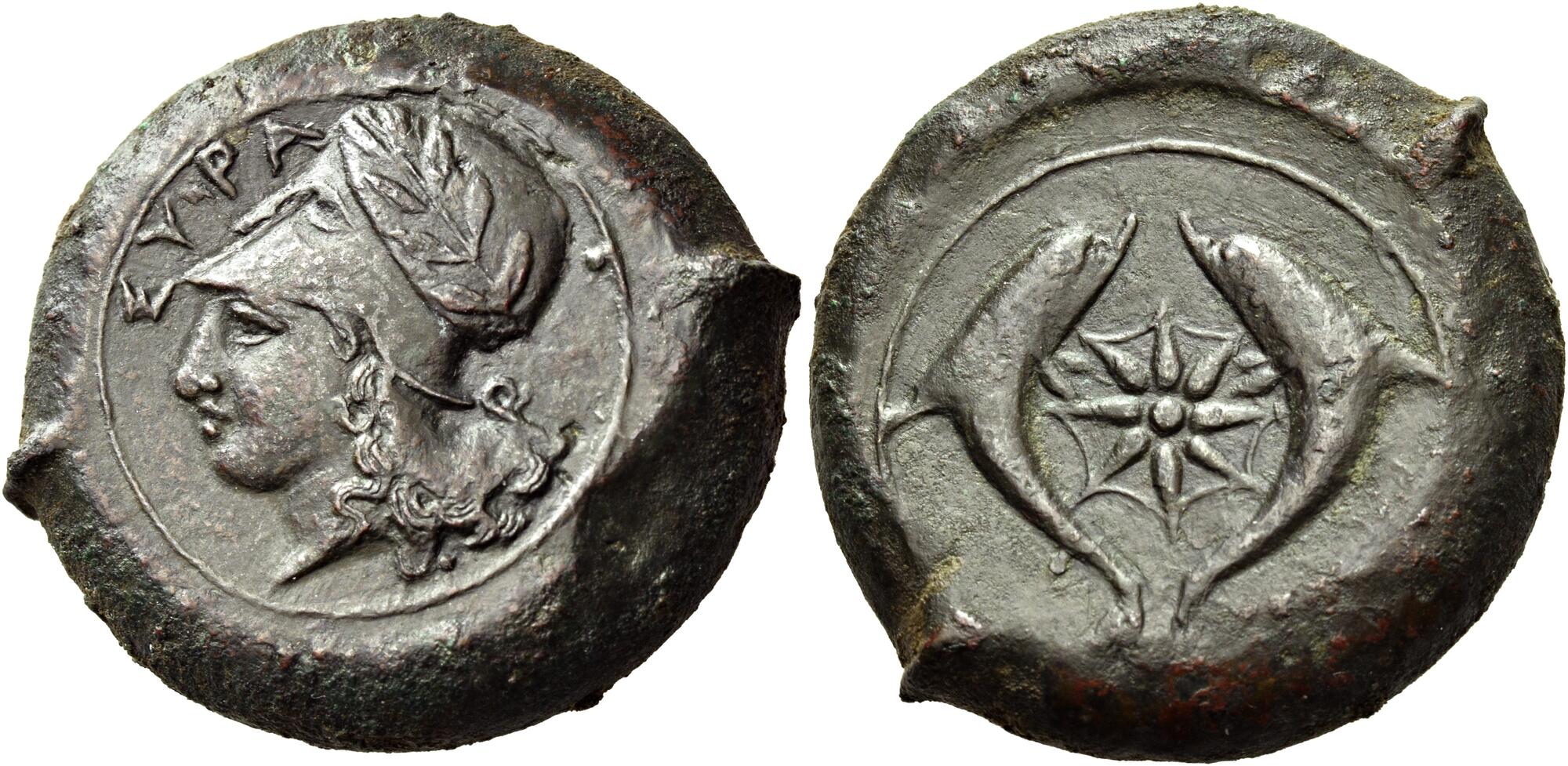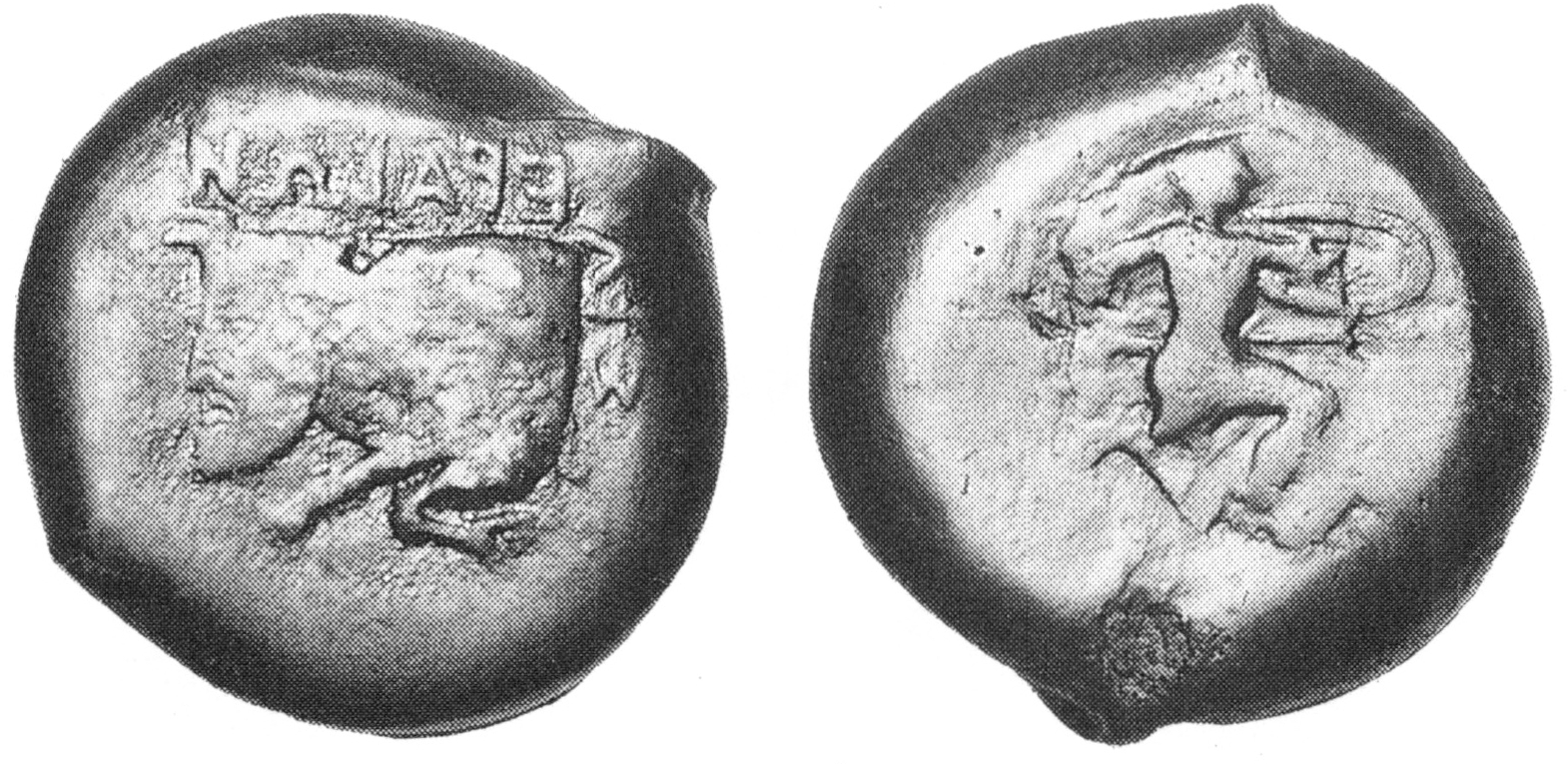340 BCE - 330 BCEΣIΛEΡAIΩN | ΣΙΛ
Overstruck variety
Syracuse Athena-dolphins.jpeg
[2]
|
|
Sale(s)Sale(s) ᵖ:
|
Classical Numismatic Group, 45, 18 March 1998, 103
|
|
|
|
Description
| ObverseInscription or printing placed on the obverse.:
|
ΣIΛEΡAIΩN (Greek) Forepart of a man-headed bull left. Linear border.
|
ReverseInscription or printing placed on the reverse.:
|
ΣΙΛ (Greek) Warrior (Leukaspis) right, naked, wearing helmet, holding spear in right hand, shield attached on left arm. Linear border.
|
Mint and issuing power
| MintIdentifies the place of manufacture or issue of a numismatic object.:
|
Silerae
|
Ancient regionAncient region.
|
Sicily
|
Modern countryModern country: Italy
|
AuthorityIdentifies the issuing power. The authority can be "pretended" when the name or the portrait of X is on the coin but he/she was not the issuing power. It can also be "uncertain" when there is no mention of X on the coin but he/she was the issuing power according to the historical sources:
|
Campanian mercenaries
|
Chronology
| FromIdentifies the initial date in a range assigned in a numismatic context. 340 BCE toIdentifies the final date in a range assigned in a numismatic context.. 330 BCE
|
Classical 480-323 BC  periodTime period of the numismatic object. periodTime period of the numismatic object.
|
Physical description
MetalThe physical material (usually metal) from which an object is made.: Bronze 
|
WeightWeight of the numismatic object (in grams). in grams: 36.7036.7 g <br />36,700 mg <br />
|
DenominationTerm indicating the value of a numismatic object. Examples: tetradrachm, chalkous, denarius.: drachma 
|
|
| DiameterDescribes diameter of an object (in mm).: 3131 mm <br />3.1 cm <br />
|
|
References
Description
| ObverseInscription or printing placed on the obverse.:
|
ΣΥΡΑ (Greek) Head of Athena left, wearing Corinthian helmet decorated with ivy wreath
|
ReverseInscription or printing placed on the reverse.:
|
Two dolphins flanking stylized starfish
|
Mint and issuing power
Chronology
| FromIdentifies the initial date in a range assigned in a numismatic context. 400 BCE toIdentifies the final date in a range assigned in a numismatic context.. 367 BCE
|
Classical 480-323 BC  periodTime period of the numismatic object. periodTime period of the numismatic object.
|
Physical description
| DenominationTerm indicating the value of a numismatic object. Examples: tetradrachm, chalkous, denarius. ᵖ:
|
drachma 
|
|
|
References
References
- ^ Calciati, Romolo (1987), Corpus nummorum siculorum. La monetazione di bronzo/The bronze coinage, vol. 3, Milan, Edizioni G. M.
- a b Hoover, Oliver D. (2012), The Handbook of Greek Coinage Series. 2. Handbook of the Coins of Sicily (Including Lipara). Civic, Royal, Siculo-Punic, and Romano-Sicilian Issues. Sixth to First Centuries BC, Lancaster-London, 489 p.
- a b Puglisi, Mariangela (2009), La Sicilia da Dionisio I a Sesto Pompeo : circolazione e funzione della moneta, Messina, DiScAM, p. 519.
- ^ Calciati, Romolo (1986), Corpus nummorum siculorum. La monetazione di bronzo/The bronze coinage, vol. 2, Milan, Edizioni G. M.
- ^ Sylloge Nummorum Graecorum ANS 5. The Collection of the American Numismatic Society. Sicily 3. Syracuse-Siceliotes, New York, 1988,

